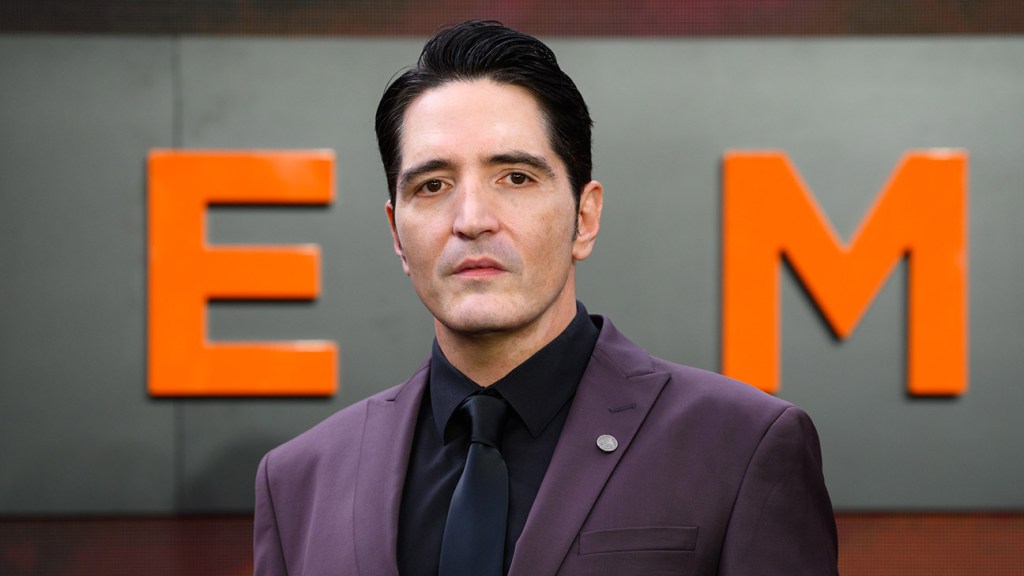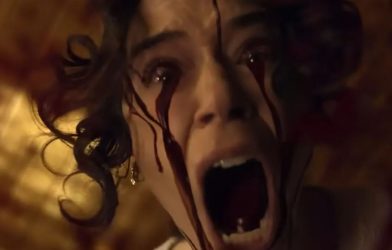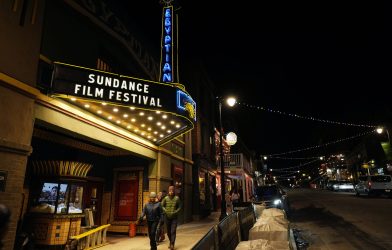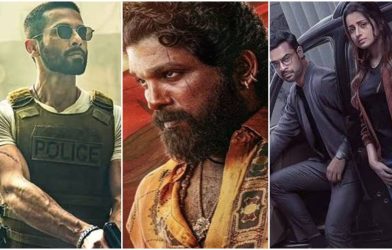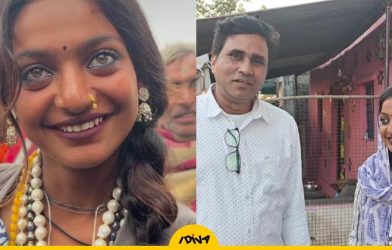
David Dastmalchian
Joe Maher/WireImage
For Late Night with the Devil star David Dastmalchian, all roads lead to and from Christopher Nolan.
In 2007, Dastmalchian was a struggling local theater actor in Chicago, and when Nolan’s The Dark Knight set up shop in the Windy City, he went through a circuitous casting process before eventually landing a part in his very first feature film. Dastmalchian played Thomas Schiff, a paranoid schizophrenic and former Arkham Asylum inmate that Heath Ledger’s The Joker disguised as his fellow honor guardsman during their infiltration of Commissioner Loeb’s funeral procession. When gunshots rang out and chaos ensued, Harvey Dent (Aaron Eckhart) cornered Schiff in an ambulance and then forcefully interrogated him in another location.
14 years later, as Dastmalchian began to prepare for the role of the charismatic but troubled late-night talk show host Jack Delroy in Cameron and Colin Cairnes’ Late Night with the Devil, his greatest inspiration came from a place that brought him right back to his Dark Knight days.
“The Cairnes brothers sent me a bunch of footage that they accumulated of Don Lane. He was the Johnny Carson of Australian television. He did this famous interview with Tom Waits, and a lot of people think Heath Ledger took inspiration from it for his portrayal of The Joker,” Dastmalchian tells The Hollywood Reporter. “[The likelihood of shared inspiration] is pretty cool, and it’s also the cyclical nature of being a storyteller and the strange path that it’s followed.”
The full circle doesn’t end there, as Dastmalchian reunited with Nolan in 2022 for a key role as William L. Borden in the British-American filmmaker’s now Oscar-winning Oppenheimer (2023). In and around filming, Nolan made a point to not only compliment Dastmalchian’s performance as Polka-Dot Man in James Gunn’s The Suicide Squad (2021), but he also inquired about his collaboration with their mutual friend, Denis Villeneuve. Dastmalchian has worked with Villeneuve on three films to date including Prisoners (2013), Blade Runner 2049 (2017) and Dune (2021).
“One of the first things [Villeneuve] said to me [on the Prisoners set] was, ‘I want to hear about your experience on The Dark Knight. I want to know what it was like to work with Christopher Nolan,’” Dastmalchian recalls. “And then ten years after we made Prisoners, I’m now reunited with Christopher Nolan on the set of Oppenheimer, and we’re talking about how much he loves the work of Denis Villeneuve. He was the one now asking me questions about my experiences on set with our friend Denis. So to know that I’m a tiny little thread between these two artists, I found that to be a wildly fascinating life moment.”
In addition to Nolan and Villeneuve, the Overland Park, Kansas-raised actor has made a name for himself whenever a story needs an atypical wildcard character that’s often afflicted or suspected in some way. Thus, when Late Night with the Devil producer Roy Lee emailed him with an offer for the starring role in the Cairnes brothers’ found-footage horror film, Dastmalchian assumed they’d made a mistake.
“I looked at the log line and said, ‘Which lead? There’s no way anybody thinks I’m the guy to play a late-night talk show host. There’s a lot of roles that I can imagine myself slipping into: Bond villain, Sith Lord, cult leader, creepy suspect number 17, but charming, witty, funny talk show host!?”” Dastmalchian says of his own skepticism.
Below, during a conversation with THR that predates Oppenheimer’s Oscar glory, as well as Late Night’s recent controversy involving three AI-generated images, Dastmalchian discusses a pivotal day on the Cairnes brothers’ set, before explaining how a brief moment in Oppenheimer also harks back to The Dark Knight.
Well, the band took over directorial duties mid-pandemic, so I understand the delay, but I am once again asking one of the stars of the upcoming Failure documentary when it will see the light of day.
(Laughs.) It’s so close! I was just emailing with [Failure frontman] Ken [Andrews] two weeks ago about it. It’s so close, and I’m so excited, man. It’s going to be awesome. I’ve had so many Failure conversations lately. I always do, but I was just doing one of these interviews where they’re like, “What’s your desert island jukebox? What three albums?” And, of course, Failure’s Fantastic Planet was one of them.
I talk about the documentary like it’s my movie, but I’m just trying to help Ken. Jordan Helman is the head of scripted TV at Hulu, and we bonded over Failure when we were working on Reprisal. So I told him that I’m friends with Ken, and then I brought him out to Ken’s studio a few months ago to watch some of the documentary together. And both of us were just like, “Dude, this has to get finished. We have to see this.” And so hopefully there’s news on that soon.

David Dastmalchian in LATE NIGHT WITH THE DEVIL
Courtesy of IFC Films and Shudder
We talked previously about how Ant-Man and the Wasp: Quantumania’s Veb came along at a time when you really needed a boost. So where were you mentally, emotionally and physically when Late Night with the Devil showed up in your inbox?
It was pandemic time, and it was a supremely tricky moment in reality where things were feeling so uncertain and so scary. I was trying to construct and manufacture this exterior persona of confidence and calm and calculations, so that my children could feel safe and think that I’ve got stuff figured out and that things were going to be okay. Internally, I was unable to sleep. I was racked with crazy anxiety and fear about the state of the world and politics in our country, and what’s happening with science. I also had the terribly devastating loss of my mother unexpectedly, and the grief process was really tricky for me.
But then my friend Roy Lee emailed me, and I’ve known him for a long time. He’s the phenomenal producer behind things like the It franchise and The Ring and How to Train Your Dragon. And he said, “I’ve got this very small project that I’m involved in. I love it. The guys making it [the Cairnes brothers] want you to play the lead.” And so I looked at the log line and said, “Which lead? There’s no way anybody thinks I’m the guy to play a late-night talk show host. There’s a lot of roles that I can imagine myself slipping into: Bond villain, Sith Lord, cult leader, creepy suspect number 17, but charming, witty, funny talk show host!?”
So I looked at their designs and their vision for the film, and it was like looking into a time capsule of the 1970s. They just got this world. I then started to read the script, and here was this story about a man who’s manufactured this persona of confidence and grace and ease and comedic timing and charm and wit for a national viewing audience on a nightly basis, while, privately, he is deep in the throes of a nervous breakdown and losing not only his tether on his career but his own sanity. And I went, “Well, fuck!”
My therapist says to me: “When the student is ready, the teacher arrives.” And when I was ready, this role came to me, but I was so scared of it, dude. I was like, “There’s no way I can pull this off, but I am going to sure as hell try.” It was one of the biggest challenges I’ve ever been handed as an actor, and being in the hands of these two incredible hard-working filmmakers, it was just this wonderful safe space on a stage in the middle of Melbourne, Australia. I could get so vulnerable and do all the things I’ve learned as an actor to try and manifest something here. So it was an incredible experience, and from day one of filming, I was already excited about sharing this movie with the world. And now I’m finally doing that.

Ingrid Torelli, David Dastmalchian, Laura Gordon in LATE NIGHT WITH THE DEVIL
Courtesy of IFC Films and Shudder
Did you go down a YouTube rabbit hole of ‘70s talk shows? Did you reach out to any talk show hosts for insight?
I spent hundreds of hours. I’m not exaggerating. From the time that I said yes, I had about three months, maybe longer. The Cairnes brothers sent me a bunch of footage that they accumulated of Don Lane. If you’re not familiar with Don Lane, he was the Johnny Carson of Australian television. He was an American who lived in Australia, and he became the host of this huge syndicated talk show [The Don Lane Show]. He did this famous interview with Tom Waits, and a lot of people think Heath Ledger took inspiration from it for his portrayal of The Joker.
Famously, in 1983, on the last night of The Don Lane Show, David Bowie was down the block at a restaurant, and because he always loved watching Don’s show while touring Australia, he was like, “Oh, it’s Don’s last show?” So he walked onto Don’s show and went, “Hey Don, I heard it’s your last show,” and they did an impromptu interview. So Don Lane was a huge influence.
As a kid, I watched shock TV hosts like Morton Downey Jr. and Phil Donahue, and I found them utterly fascinating [during prep]. And then I, of course, watched Johnny Carson, Dick Cavett, David Letterman. Having the YouTube library of all of that stuff meant that every night before going to sleep, I would just put their videos on and leave them running as I would fall asleep.
This role was like being a jazz drummer and then all of a sudden getting asked to sit in for Tool drummer Danny Carey on tour. It just wasn’t in my wheelhouse, man. I’m not the guy who’s funny. I’m not a comedian. I have a lot of skills as an actor, but to make this shit feel authentic and real was so terrifying for me. So I wanted to study every idiosyncrasy, the way that they gestured and the way that they’d land joke punchlines. We maybe had 15 days to shoot this movie’s long takes, so I knew I didn’t have a lot of room for error and I needed to come ready. I didn’t actually get to talk to any talk show hosts, but I did continue to watch every opening monologue and interview segment that I could find from any of the legends all the way through shooting.
Given your Dark Knight character’s ties to Heath Ledger’s Joker, it’s interesting that you more than likely used the same source of inspiration that he relied on during 2007’s production.
It’s pretty cool, and it’s also the cyclical nature of being a storyteller and the strange path that it’s followed. As a theater actor from Chicago, the first time I ever stood on a set was The Dark Knight, and now, all these years later, I’m a part of Oppenheimer and I’m seeing the impact that it’s having on audiences, culture, society and cinema history. I believe that it’s a really important part of cinema history, and so it’s made me very nostalgic. It reminds me how much my life has changed, from being a theater actor who’d never been on a film set before, to standing two feet away from one of the greatest actors of our time, Heath Ledger, and now standing next to two more of the greatest actors of our time, Cillian Murphy and Robert Downey Jr. So to be a small part of these people’s creations is wildly humbling and surreal to say the least, and I still feel a bit of shock and awe that this is all really happening.
Oddly enough, Late Night with the Devil’s Jack Delroy is supposed to be a member of “The Grove,” which seems to be loosely inspired by the Bohemian Club that meets among the redwoods at the Bohemian Grove campground in Sonoma County. Did you know that a key Manhattan Project meeting with J. Robert Oppenheimer took place there?
I think I had heard that, but I was more familiar with Jack Parsons connections to it than Oppenheimer’s. He was another fascinating scientist who had a huge impact on the way that things went, but I will say that it doesn’t surprise me. As an armchair conspiracy theorist, the Bohemian Grove and the club and the secrets contained within those titans of all power is creepily intriguing to me. It makes you wonder about what secret handshakes and backroom conversations took place there.
Now, the opening of the film sums up Jack Delroy’s career until a fateful night in 1977, and magazine covers are used to help tell the story: Newsweek, Variety and Hollywood Observer, the latter of which has a similar logo to The Hollywood Reporter. Did THR not give approval?
I’ll find out because I don’t know. That’s a great question, though, because why were we allowed to use Variety but not THR? Maybe [THR film editor] Aaron Couch and [THR senior film writer] Borys Kit shut it down. They’re the mean ones. You’re the nice one.
Aaron was so upset that your recent casting scoop for Apple TV+’s Murderbot went elsewhere that he retroactively denied use of the THR brand.
(Dastmalchian roars with laughter.) But all those little details add up in creating a world that I hope audiences believe. They make it easy to transport yourself and your imagination into the real 1977 late-night culture of talk show, television, entertainment and me-centered show business. The Cairnes brothers were so good at manifesting this, and every time I would step on the Night Owls with Jack Delroy set, I felt like I was stepping back in time. Every time that little door would slide open and I would go out to meet with a new guest or go out to shoot a new segment, it felt like I was really there. They even used the big tube TV camera apparatus as props, and while our actual camera team shot with three cameras at once, they were also operating around those cameras. So I always felt like I was actually on the set of a live TV broadcast. I even had my very own version of Paul Shaffer just jamming out with a live band right next to me. It was wild.
You were number one on the call sheet, so how did you take to setting the tone amongst the cast?
I was genuinely scared. I knew that if I didn’t nail the musicality, the presence and the tonality of this figure, then the whole house of cards was just going to collapse. So I probably started off on shaky legs, and if people were looking at me to set a tone, then they were probably sorely disappointed. I did my best to feign ease and confidence, but I was genuinely petrified, man. Early into production, there was this big day with the opening monologue, and I knew it would really define whether or not I would be able to pull this off. They packed the risers with all of our audience cast, and I took a big deep breath and leapt into the darkness of being the central protagonist of this story. And the next thing I knew, it was over, and Cameron and Colin Cairnes, the writer-directors, came walking over to me with these genuine looks of satisfaction on their faces. They gave me a big hug and said that’s what they wanted. So then I just settled in from that point forward. The fear was still always there, but I felt so much joy making this movie. It was not an experience that I ever expected to have in my career, but it was definitely one of the best.

David Dastmalchian in LATE NIGHT WITH THE DEVIL
Courtesy of IFC Films and Shudder
This movie is told through found footage, specifically a master tape of the live show in color and behind-the-scenes footage in black and white. Oppenheimer also used both formats. How did you approach the black-and-white material on the day?
Those were the moments when I tried to strip away the persona of Jack Delroy and all of the charm, wit and shtick of being a late night talk show host. I tried to strip everything away and be as vulnerably naked as possible, so that I could be the scared, depressed, grieving, disintegrating person that’s at the heart of this story and who I have been many times in my life. I’ve chosen a career and a path that puts me in situations like the one I’m in right now. I have to present a version of myself that’s helpful in promoting a product that I’m unquestionably very proud of, but it is still a different me than the guy who couldn’t sleep last night, because he had anxiety about the fact that he was going to be talking to people today about things that could potentially be triggering. So that’s the power of cinema. That’s what makes this shit so amazing.
Are you responsible for Delroy’s Vincent Price reference, given that he’s a hero of yours?
I am not conscious if I was responsible for the Vincent Price reference, but I was absolutely responsible for the shout-out to Berwyn, Illinois, which those in the know will recognize as a nod to the home of Svengoolie, late night host of Chicago fame.

David Dastmalchian and Denis Villenueve on the set of Prisoners
Wilson Webb
Your Oppenheimer character’s last name is Borden, and that just so happened to be the last name of Christian Bale’s character [Alfred Borden] in Christopher Nolan’s The Prestige. Did you and Chris ever note this coincidence?
We didn’t talk about that coincidence, but we did talk about a number of really fascinating things during my opportunities to be on set for Oppenheimer, which included getting to hear him talk about other filmmakers whose work he appreciated. In fact, when I went to read the script at Universal, I got to say hi to him after I finished reading it. And I basically haven’t seen him since The Dark Knight other than one chance run-in at a park when I was playing with my kids. So I got a chance to thank him for inviting me to be a part of [Oppenheimer], and then he told me how much he had enjoyed seeing me as Polka-Dot Man in James Gunn’s The Suicide Squad. It made me feel very happy to know that he not only saw it, but that he also liked it. And as we continued to work together, I knew that there was a mutual appreciation and friendship between himself and Denis Villeneuve.
I’ll never forget when I first got to Atlanta [in 2013] to start working on Prisoners with Denis. Having never met him before, one of the first things he said to me was, “I’m really busy prepping this movie, but when we get a chance to talk, I want to hear about your experience on The Dark Knight. I want to know what it was like to work with Christopher Nolan.” And then ten years after we made Prisoners, I’m now reunited with Christopher Nolan on the set of Oppenheimer, and we’re talking about how much he loves the work of Denis Villeneuve. He was the one now asking me questions about my experiences on set with our friend Denis. So to know that I’m a tiny little thread between these two artists, I found that to be a wildly fascinating life moment. It’s a neat feeling to know that I’ve gotten a peek into their processes and that I know how much they respect and admire one another’s creations.

David Dastmalchian in The Dark Knight
Warner Bros.
For the shots of Borden and Oppenheimer in the bomber, did you and Cillian jump in and out of that rig on the same day?
I do believe that Cillian and I both sat in that bomber on the same day. There’s something profound and powerful about that moment in the film, and it’s something that speaks to Chris Nolan’s keen understanding of how audiences perceive image as well as emotion. Putting Oppenheimer in that space, through his imagination, so that he could see a little glimpse of horror that my character had shared with him, it’s something that Nolan has done time and again in his films. [Writer’s Note: Nolan does something similar in The Dark Knight Rises when we see two different outcomes of Alfred’s Fernet-Branca-fueled holiday in Florence. Memento has its own version of this with Sammy Jankis and Leonard.]
In The Dark Knight, we shot that whole parade sequence in downtown Chicago: [Thomas Schiff] getting shot in the leg, being interrogated in the back of the ambulance by Harvey Dent, who then steals the ambulance and takes him somewhere else to find out what he knows about the Joker. So the sequence in this abandoned space where Schiff is then tied up and interrogated at gunpoint, we did not shoot that until several months later in London. We shot it at the Battersea Power Station, and at that time, it had not been renovated the way it is to this day.
And that sequence was shot at the same location where they shot the end of the film, when Harvey has gone full Two-Face and he’s kidnapped Gordon’s kid. They’re not meant to be the same location in the story, but visually, texturally, atmospherically, it has the same vibe and the same feeling as the scene where Harvey Dent is holding a gun to [Schiff’s] head. That’s when he first started to bend all the rules of his own ethics and morality to try and to save lives.
I always thought that was so cool even though there wasn’t a connection between these two locations, narratively. But, for the audience, visually, aesthetically, and subconsciously, seeing Harvey’s character turns occur in a similar location has all of the power of what we can do with moving image, and it’s why choices like that are so powerful. So I think about that a lot and how cool it was that Chris also put Oppenheimer in the same cockpit as my character.
***
Late Night with the Devil is now playing in movie theaters.

